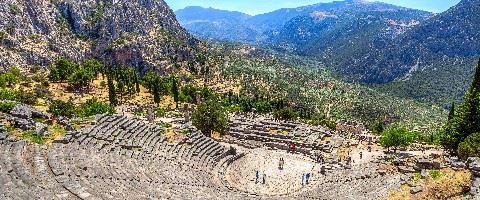Mountains and plains make up the bulk of central and northern Greece. The main draw in central Greece is of course Delphi – not only the most important ancient site in Greece but one of the most dramatically sited, on the slopes of steep Parnassos and boasting glorious views to the sea.
After Delphi, the other ‘must-see’ is the Meteora, the collective name for some half-dozen monasteries dating from the 14th century and perched unfeasibly on the top of sheer pinnacles of rock (‘Meteora’ means ‘rocks in the air’). They are an extraordinary sight, and have even starred in a James Bond film! The small town below, Kalambaka, is where most visitors stay, but we prefer the more villagey feel of Kastraki just up the road.
Between Delphi and Meteora is the Pelion, one of the most naturally beautiful areas of Greece. The peninsular is well covered elsewhere in this brochure and it goes without saying that a visit is highly recommended. If you want to visit the Meteora for the day, it can be reached from Volos in approx. 2 hours drive, as the road is fast (part-motorway) and flat.
Continuing north the coastal highway passes beneath the shadow of Mount Olympus, at 2917m Greece’s highest peak and legendary home of the gods. For those who’d like to walk or explore the area we’d recommend a stay in the hillside village of Ambelakia a little to the south, which has an authentic mountain village feel yet quick access to the main road below.
Macedonia was Alexander’s domain. The capital Thessaloniki is now a thriving modern metropolis with a fascinating past evidenced by the many monuments and sites in the heart of the city – the archaeological museum is a highlight, as is a trip to Philip’s tomb at Vergina. Western Macedonian attractions include sites such as Dion and Pella, cliff-top Edessa with its waterfall, the handsome lakeside town of Kastoria, and the Prespa Lakes for anyone with an interest in ornithology.
To the south Halkidiki is famous for the holy mountain Athos, and for stunning white-sand beaches backed by pine forests. Our chosen bolt-hole here is the small village of Olymbiada, tucked away from the crowds in the north-east corner – see resort pages for details.
To the east, the main draw is the large Roman site of Philippi near Kavala, where St Paul began his European mission. Thrace borders Bulgaria and Turkey – the small town of Xanthi is a fascinating melting-pot of cultures and worth a stop, especially if you can be there for the bustling Saturday morning market. Alexandroupolis in the far east is recommended as a base for ornithologists, as it is next to the Evros Delta, and you can also drive to Dadia forest which has a raptor reserve.







